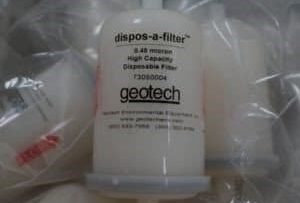
Another group of parameter-specific field protocols that must be evaluated and included in the SAP are methods for sample pretreatment, including sample filtration and physical and chemical preservation. ASTM has published Standard Guides that address both types of sample pretreatment. ASTM Standard D 6564 (ASTM, 2004k) provides a detailed guide for field filtration of ground-water samples, and ASTM Standard D 6517 (ASTM, 2004l) discusses physical and chemical preservation methods for ground-water samples.
Filtration
Ground-water sample filtration is a sample pretreatment process implemented in the field for some constituents, when it is necessary to determine whether a constituent is truly “dissolved” in ground water: Filtration involves passing a raw or bulk ground-water sample directly through a filter medium of a prescribed filter pore size either under negative pressure (vacuum) or under positive pressure. Particulates finer than the filter pore size pass through the filter along with the water to form the filtrate, which is submitted to the laboratory for analysis. Particulate matter larger than the filter pore size is retained by the filter medium.
The most common method for distinguishing between the dissolved and particulate fractions of a sample has historically been filtration with a 0.45 μm filter. The water that passes through a filter of this pore size has, by default, become the operational definition of the dissolved fraction. Filtration helps minimize the problem of data bounce, which commonly results from variable levels of suspended particulate matter in samples between sampling events and individual samples, making trend analysis and statistical evaluation of data more reliable. In addition, filtration makes it easier for laboratories to accurately quantify metals concentrations in samples. Perhaps most importantly, filtration of samples makes it possible to determine actual concentrations of dissolved metals in ground water that have not been artificially elevated as result of sample preservation (acidification), which can leach metals from the surfaces of artifactual or colloidal particles.
Filtration is not always appropriate for ground-water sampling programs. The pressure change that occurs when the sample is brought to the surface may cause changes in sample chemistry, which include loss of dissolved gases and precipitation of dissolved constituents such as metals. When handling samples during filtration operations, additional turbulence and mixing of the sample with atmospheric air can cause aeration and oxidation of Fe2+ to Fe3+. Fe3+ rapidly precipitates as amorphous iron hydroxide and can adsorb other dissolved trace metals.
Analytical Parameter Filtration Recommendations
Examples of parameters that may be field filtered
-
- Alkalinity
-
- Trace metals
- Major cations and anions
不适用于样品过滤的分析参数
- VOC
- TOC
- TOX
- 溶解性气体(DO, CO2)
- 物质总量分析(不如总砷)
- 低分子质量,高溶解度,非反应性成分
有多种方法可用于地下水样品的现场过滤。在一般来说,过滤设备可分为正压过滤(胶囊式过滤,注射器过滤器,碟片式过滤器)和真空(负压)过滤方法。
在线连接的碟片式过滤器
使用胶囊式过滤器进行地下水样品的过滤
物理与化学方法对地下水样品的保存
地下水样品预处理的第二种形式是物理和化学保存:如ASTM标准D6517(ASTM,2004)中所述,地下水样品在采集期间被带至地表环境后,相对于原位条件而言会不可避免的发生化学、物理和生物学变化。除了本章前面讨论的取样装置可能带来的任何变化外,这些变化包括暴露在环境条件下,如压力,温度,紫外线,大气中的氧气和大气污染物。
地下水样品的物理保存方法包括:(1)对每个被分析的参数使用合适的样品容器; (2)使用适当的样品包装,以防止在运输到实验室过程中发生损失;和(3)在送到实验室的过程中对样品的温度具备控制。
化学防腐包括在样品采集过程中向地下水样品添加一种或多种化学试剂。化学品可以用来调节样品的pH值,使分析物成分保持在溶液中不受任何变化,或抑制样品的微生物降解。
制定采样计划时,要包括如何预处理采集的样品,选择合适的样品容器、化学预处理药剂
地下水样品可以通过以下几种方法之一进行化学保存:(1)使用pH测量仪或窄频石蕊试纸监测pH值变化的同时进行pH滴定(如硝酸); (2)向样本容器中加入固定体积的液体防腐剂(例如玻璃小瓶或安瓿瓶装的硫酸); (3)向样品容器中加入固定量的粒状防腐剂(例如氢氧化钠);或(4)在将容器运往现场之前将防腐剂放置于空样品容器中。
